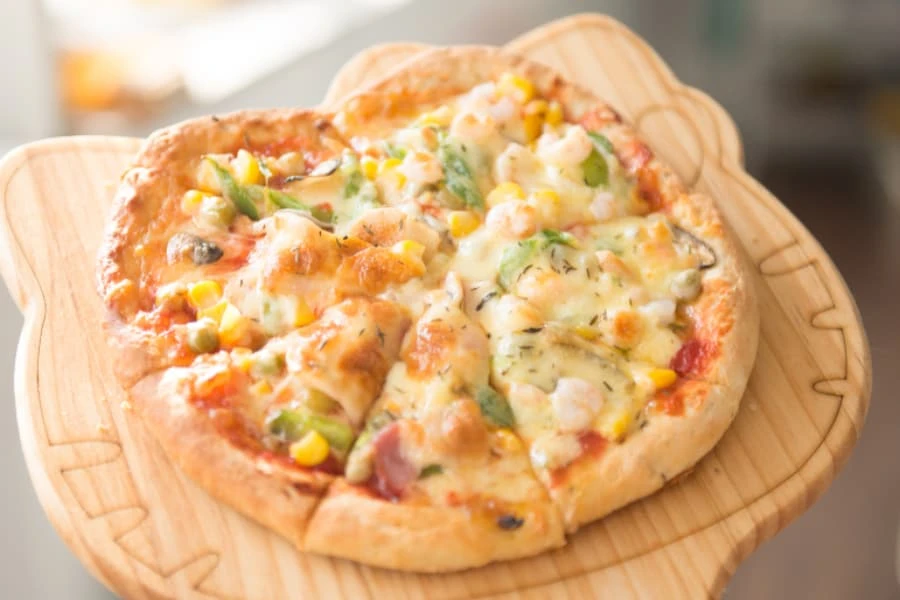We all love that crunchy pizza because of its delicious taste and high hunger-bursting powers, but we hardly care about how many calories we stuff into the body with it. The regular consumption of pizza has been linked to high cravings for it. Though there are healthier pizza choices these days, you just have to check for the types and quantities of ingredients they come with. Pizza is the number one quick meal in the world today, and it is even more popular as lunch for students, office workers, and home-based mothers.
So, Is Pizza Good for Weight loss?
No, pizza is known for its high amount of calories, sodium, fat, and additives such as coloring. High-calorie foods are not good for weight loss.
Nutritional Breakdown Of Different Types Of Pizza
The nutritional components of pizza are the same, just that they come in different quantities or variations depending on the type of pizza you have. The following is the nutritional breakdown of pizza.
1. Frozen Pizza
Frozen pizza is one of the most popularly consumed types of pizza in the world today. This is the most popular snack for college and university students and busy families. Frozen pizza is high in sodium, fat, and sugar. Since it is a processed meal, it is also high in additives like colorings, preservatives, and sugar.
One serving of frozen pizza, which could be ¼ pizza of classic crusty pepperoni frozen pizza, may contain up to 380 calories, 18g of fat, 39g of carbs, 8g of sugar, and 810mg of sodium. Additives will come in the form of the toppings you choose; for instance, sausage or cheese toppings will drastically increase the total calorie amount. The same goes with type; French bread or stuffed crust, for instance, may also add up to the total calories.
2. Fresh Pizza
Fresh pizza is unfrozen, out of the bakery pizza. It also contains varieties of ingredients, just like the frozen version. Though fresh pizzas like the pizzeria pizza don’t always come with their ingredients list on the package, they tend to contain healthier ingredients than the pizzas sold in convenience stores and fast-food destinations.
Makers of fresh pizzas do make the doughs right from scratch, while many frozen pizzas come with already-made dough, frozen for hours and sometimes days. Many fresh pizza makers will use hand-made sauces with fresh cheese and no added sugar as part of their ingredients.
You will have the choice of requesting the pizza topping, but if you want to cut calories, you should avoid toppings on your fresh pizza.
3. The Fast-food Pizza
The fast-food pizza tends to be the unhealthiest choice of the three. This is the typical pizza sold in fast-food restaurants and convenience stores. They tend to provide the highest calories, fat, sodium, and carbs. A large portion of this pizza, for instance, may provide up to 460 calories, 26g of fat, 37g of carbs, 1g of sugar, and up to 900 mg of sodium.
Fast-food pizzas do come with more ingredients than your typical freshly-made pizza. Some of the artificial ingredients you can find in fast-food pizzas are; Monosodium glutamate, also known as MSG, fructose corn syrup, and artificial colorings. Since this type of pizza comes with higher sodium levels, it may increase your salt intake drastically, a condition that can lead to a spike in blood pressure.
Reasons Why Pizza May Not be Good for Your Health
Pizza has become a great treat to us, and there is no harm in eating it once in a while, but taking too much, especially daily, can create some complications. Just like much other calorie-loaded junk food, daily consumption of pizza can lead to quick weight gain, higher cholesterol, and digestive complications.
A single slice of pizza, for instance, may contain up to 300 calories and up to 700mg of sodium plus 14g of fat, which will translate to a whole lot more if you have to consume the medium or large-size pizza. The following are reasons why pizza may be unhealthy for your body;
1. Pizza Comprises of Refined Flour
Refined flour can be very harmful to your health, and pizza has lots of it. Refined flour is a processed grain, and most of the nutrients are lost during the refining process. The essential vitamins and fiber that are needed for many processes in the body might have been lost during the refining process; hence you may end up piling fat, especially in your mid-section, even though there are very few to no nutrients in it.
2. Cheese Found in Certain Pizzas Can Increase Risks of Cardiovascular Diseases
It is important to note that an overdose of cheese may increase the level of bad cholesterol in your body. High cholesterol can lead to heart attack and some other cardiovascular disorders that can be difficult to manage. Chicken pizzas, as a matter of fact, can’t come with even higher fat content; hence you must be careful with your pizza options.
High Sodium Levels May Raise Your Blood Pressure
All kinds of pizza, whether restaurant frozen or freshly-made, contain a high amount of sodium and may raise your blood press levels significantly, especially if you are sensitive to salt. If you have a medium to large pizza on the go, for instance, you will take more than your maximum recommendation for daily sodium intake.
3. Pizza Can be Addictive
Perhaps the reason why many pizza lovers become overweight is because of the addictive nature of the food. There are a number of ingredients included in pizza that make one be addicted in no time. The more you consume pizza, the more certain brain hormones that make you become more addictive are secreted.
4. Pizza Can Increase Blood Sugar Levels Sharply
Just like carbonated sugary drinks, blood sugar level spikes are associated with continuous sugar consumption. It can suddenly increase your blood sugar levels and then crash afterward, making you develop fatigue and some other symptoms. The high amount of refined flour plus lots of additives like flavorings, colorants, and preservatives are the reason why pizza causes a sharp increase and crashing of blood sugar.
5. Pizza Increases Acidity
Certain ingredients, including flour, cheese, and sauce, can increase acidity in your digestive tract, and this can lead to stomach upset and some other complications. If you are already a victim of an acidic stomach, you should abstain from pizza. Acidity has been associated with leaky guts, diarrhea, and many other gastrointestinal disorders.
How Can You Lower The Health Risks In Pizza?
There are certain steps you can take to lower the health risks of pizza consumption. Despite its high calorie, fat, and sodium components, there are some ways by which you can still enjoy pizza’s benefits without causing harm to your body. Whether you want restaurant type, frozen or freshly-made, you should consider the following;
1. Make Your Own Pizza
Since you don’t have control over what is put inside your pizza, you should aim at making your own to reduce certain types of unhealthy ingredients. Making your own pizza gives you the power to dictate what goes in and out of it. You can make your own pizza crusts with healthier whole grains to boost your fiber intake, and you can also opt for a gluten-free option if you are sensitive to gluten.
You can also use options like nut flour or cauliflower to make your own grain0free pizza crust. You may want to add an unsweetened topping sauce and good-quality cheese. Consider adding healthier toppings like pepper, broccoli, mushrooms, or dried tomatoes.
2. Choose Whole Ingredients Only
When making your own pizza, you should go for whole ingredients instead of processed ones. You may want to check your pizza’s ingredient lists and then choose the whole ingredient alternatives to any processed ingredients listed.
Substitute crust mixes made from high fructose corn syrup, processed meat, artificial colors, added sugars, and preservatives. Create your own pizza crusts with natural ingredients.
3. Control Your Portion Sizes
If you can’t make your own pizza, then you need to exercise some control over your servings. Sliced pizza should make this habit a lot easier for you; otherwise, you should slice up your homemade pizza yourself. With sliced bits, you will consume much less pizza at a time. Imbibe the habit of eating pizza from a plate and not the box, and this will help you control your ratio.
Conclusion
With the information provided above, it is easier to conclude that pizza is not good for weight loss. For this reason, you should abstain from consuming unhealthy snacks. If it is impossible to stop consuming pizza, you must find a healthier way to prepare and enjoy it. The addictive nature of pizza can make it difficult to control your appetite for these snacks, but the more you replace unhealthy ingredients with healthy ones, the quicker you can stop excessive weight gain and other health issues associated with addictive pizza consumption.







